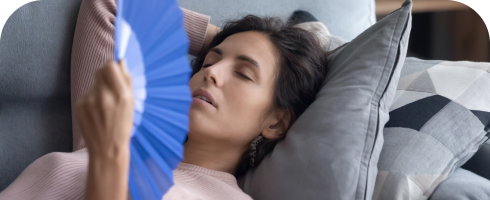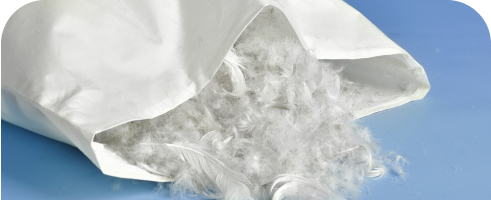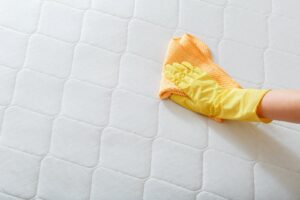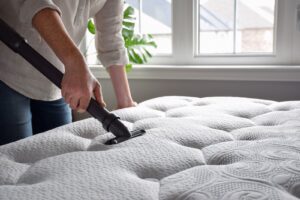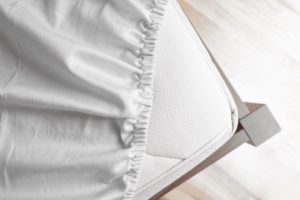Types of Pillows
Your pillow is an essential part of restorative sleep. The best pillow cushions your head and neck while keeping them aligned with your body to minimize strain and discomfort.
Pillows come in several shapes and sizes with varying types of fill. With so many options, there’s a lot to consider when shopping for a pillow. Besides assessing the materials and construction, you should also factor in your unique needs. Sleep position, body type, and personal preference all play a role in which pillow is best for you.
To help you understand the different pillow types and who they’re ideal for, we’ll describe fill materials and explain general performance characteristics. We’ll also explore different pillow shapes and sizes on the market. Finally, we’ll discuss the specific pillow needs of different sleep positions.
Find a Pillow That’s Right for You
Looking for a new pillow? Take the quiz below to find the perfect pillow for your needs.
Trouble sleeping?
Answer these 5 easy questions to discover your perfect pillow

Trouble sleeping?
Answer these 5 easy questions to discover your perfect pillow
What position do you sleep in?

Side

Back

Stomach
Types of Pillow Fill: Explained
Pillows are typically categorized by their fill, which can include natural materials, synthetic materials, or a combination of the two. While fill varieties vary in their feel and performance, each is well suited to some sleepers. We’ll explain common materials, how they feel, and their key characteristics.
Memory Foam
Memory foam, also known as viscoelastic foam, changes shape in response to heat and pressure. Because of this trait, a memory foam pillow molds to a sleeper’s head and neck for customized pressure relief and spinal support.
Memory foam’s density and close hug often lead to heat retention, so many manufacturers include features designed for cooling, such as gel infusions. Additionally, many pillows that contain memory foam have an initial odor due to volatile organic compounds (VOCs) left over from the manufacturing process. This should air out within a few days as long as you leave the pillow in a well-ventilated room.
Two types of memory foam pillow fill are widely available: block and shredded. Block memory foam pillows contour evenly for exceptional support, but they’re slow to regain their shape when the sleeper moves. They’re also more prone to heat retention. Shredded memory foam pillows have a more traditional feel, allowing sleepers to scrunch and mold the pillow as needed. They’re also generally more breathable, and some have a zippered cover with removable fill for customizable loft and firmness.
Down
Down is a natural fill material that consists of quilless feather clusters from underneath a waterfowl’s rough exterior plumage. Down is extremely fluffy, making for light, plush pillows that compress beneath the head. Duck down tends to be more affordable, whereas goose down is usually softer and less likely to harbor odors.
The fill power measures how many cubic inches of loft an ounce of down occupies. This measurement reflects the down clusters’ size and quality, and higher numbers represent higher loft.
While popular for their plushness and durability, down pillows can be expensive. They may also trigger allergy symptoms for some sleepers.
Down Alternative
Down alternative imitates the plush, airy feel of down without the associated allergens. This fill is typically made of vegan-friendly polyester microfiber, though it sometimes includes other materials, such as cotton or rayon. These materials usually stay cooler than down pillows with a high fill power.
Down alternative is soft, lightweight, and moldable. It is generally more affordable and easier to care for than traditional down. Known for their versatility, down alternative pillows come in a wide range of firmness options, lofts, and price-points.
Feather
Feather pillows use the outer plumage of ducks and geese. The structure of the feathers often lends more support than down. Many pillows combine down and feathers for a balance of softness and support.
While durable, feather pillows need regular fluffing to maintain their loft, redistribute their fill, and prevent clumping. As is the case with down, feathers may trigger allergic reactions in some sleepers. New feather pillows also occasionally have an odor, and quills could poke through without a sturdy pillowcase. On the plus side, feather pillows offer many of the same benefits as down pillows, like moldability and softness, at a lower price-point.
Latex
Latex pillows are known for their responsive contouring, which cushions and supports the sleeper’s head. Like memory foam models, latex pillows come in shredded and block form. Both are typically breathable and durable. Pillows with shredded fill are more moldable, whereas block fill excels in shape retention. Some shredded latex pillows also have zippers and removable fill for adjustable loft and firmness.
Natural latex comes from rubber tree sap and is resistant to mold, mildew, and dust mites. Synthetic latex uses petrochemicals to mimic the feel of natural latex, making it more affordable but less durable. Blended latex combines natural and synthetic components to reduce the cost while using some natural material.
Two methods can be used to produce latex, leading to slightly different performance. Dunlop latex tends to be denser and more durable, while Talalay latex is light and airy.
Cotton
Cotton can be used as the primary pillow fill or blended with other materials. It’s natural, breathable, widely available, and easy to clean. The organic version is also allergy-friendly.
When used as the primary fill, cotton feels plush at first but flattens over time, making it feel firmer. Regular fluffing is essential to maintaining the pillow’s loft.
Wool
Though not widely available, sheep’s wool pillows offer durability and temperature regulation. Wool fill is simultaneously breathable, insulating, and moisture-wicking, helping sleepers stay warm in winter and cool in summer.
Naturally allergy-friendly, wool can be used by itself or combined with other materials. When used as the only fill, wool is often flat and dense with little conforming. The fill may also clump over time. Adding cotton or polyester to wool fill reduces clumping, improves moldability, and often leads to a more affordable price-point.
Buckwheat
Buckwheat pillows contain the outer hulls of buckwheat seeds. These pillows are typically firm, heavy, and supportive. Many have adjustable fill so that you can select the loft that’s right for you. Gaps in the shells also allow exceptional airflow for notable cooling. One of the most durable types of fill, buckwheat pillows can last 10 to 20 years with proper care. Once the fill wears out, you can often replace it with new buckwheat hulls to refresh the pillow.
Although buckwheat pillows conform well, their firmness isn’t ideal for everyone. The hulls also make rustling noises with movement, which could disturb sleepers who wake up easily due to noise.
Kapok
Kapok fill is a natural material that comes from the tropical kapok tree. The silky fibers are light, soft, and bouncy. They provide plush cushioning. Harvesting the fiber has a minimal environmental impact, making kapok pillows popular with eco-conscious shoppers.
While kapok’s fibers are often compared to cotton due to their appearance and fluffiness, the airy softness of the resulting pillow mimics down. Kapok pillows tend to be more expensive than cotton or down alternative models, and they require regular fluffing to maintain their shape.
Microbeads
Made of small polystyrene beads, microbeads are synthetic plastic pellets that resemble the balls inside bean bags. Sometimes called snow beads, they range from 0.3 millimeters to 0.8 millimeters in size.
Microbead fill conforms to the head and neck and eases pressure points, making it an option for people with sensitive areas. The little beads also encourage airflow to maintain a more neutral temperature. However, due to the synthetic makeup, this fill may emit chemical odors and pose a risk to the environment. Microbead pillows also tend to lose their shape over time and should be treated gently to avoid rips and leaking beads.
Pillow Sizes
Sleepers should choose a pillow size that fits their preferred position, level of activity, and bed size. Active sleepers may want a larger pillow to accommodate movement, whereas others may prefer the standard size for versatility. While some models have unique dimensions, five sizes are most common.
Pillow Sizes
| Size | Dimensions |
|---|---|
| Standard | 20” x 26” |
| Super Standard | 20” x 28” |
| Queen | 20” x 30” |
| King | 20” x 36” |
| European | 26” x 26” |
Pillow Shapes
While most sleepers are familiar with a standard rectangular pillow, different shapes are available to meet varying needs. The best pillow shape for you depends on your sleeping position, comfort preferences, medical conditions, and other personal needs.
Standard
The versatile standard pillow has a traditional rectangular shape. It is the most common option, and it is readily available with different sizes, lofts, fill materials, and firmness levels. A standard pillow accommodates any sleep position. Sleepers can place them beneath their heads, between their legs, or under their knees.
Contour
Contour pillows are usually made of firm memory foam with a curved surface to cradle the head and neck of side or back sleepers. Some knee pillows are also referred to as contour pillows. These models are designed to go between the knees of side sleepers to promote hip alignment.
Wedge
With their signature triangular shape, wedge pillows are designed to support and elevate the upper or lower body. Typically made of memory foam or polyfoam, they are popular with sleepers who have conditions that may be worsened by lying flat, such as acid reflux, GERD, and sleep apnea. Some back sleepers also use wedge pillows under their knees to reduce back strain and improve circulation.
Body Pillow
A favorite of side sleepers and expecting mothers, body pillows are extra long, typically measuring 20 by 54 inches. Sleepers can wrap their arms and legs around a body pillow or lean against it to prop themselves up. When placed between the legs, a body pillow can help promote spinal alignment and relieve pressure on the hips. Body pillows come in varying shapes, weights, and firmness levels.
Cervical
Also known as orthopedic pillows, cervical pillows are designed to provide ergonomic neck support. Often made of memory foam, they feature a raised area to support the neck’s natural curvature and a dip to cradle the head. Cervical pillows are available in multiple sizes for varying body types and sleep positions.
Roll or Bolster
The multifunctional roll or bolster pillow is shaped like a long cylinder, although some have a half-moon shape. Sleepers can use them like a body pillow or place them beneath their knees while lying on their backs. Bolster pillows are usually firm and can contain any standard fill material. They are often used for decorative purposes.
The Best Pillow for Each Sleep Position
Your sleep position greatly affects the level and type of support you need from a pillow. Whether you sleep on your side, back, or stomach, it’s critical to choose a pillow that promotes proper spinal alignment. If you switch positions during the night, you’ll probably prefer a pillow that fits your primary sleep style but is also compatible with your other sleep positions.
Because of these different needs, some pillow types are inherently more suitable for certain sleep positions. That said, each model and each sleeper is unique, so it’s important to take variations into account when selecting a pillow. We’ll break down common pillow preferences based on sleep position and suggest some pillow types that may fit the bill.
What Each Sleep Position Needs
Side Sleepers
A pillow with a medium to high loft (3 to 5+ inches) and a mid-range firmness. When lying on your side, there is a large gap between your head and the mattress. A higher loft fills in the gap to keep the head and neck aligned with the body. The firmness level also makes a difference. Side sleepers usually prefer a medium firm pillow for balanced support and cushioning.
Many side sleepers prefer a model with an adjustable loft and firmness so that they can fine-tune the pillow for their body shape and personal preference.
“Side sleepers tend to need a high-loft pillow for support and to fill the space beneath the head and neck to promote proper spinal alignment. Keep your head and neck in alignment at around 30 degrees with the help of a good pillow so your airway stays open during the night, allowing air to flow from your nose to your lungs without obstruction.”
– Sarah Silverman, Psy.D., a licensed psychologist and holistic sleep wellness consultant who treats patients in New York and Florida.
Back Sleepers
A pillow with a medium loft (3 to 5 inches) and a medium firmness. Back sleepers typically need a lower loft than side sleepers to avoid tilting their heads too far forward, which could strain their necks. The ideal pillow keeps the neck in a neutral position, neither pushing the head forward nor letting it sag. Meanwhile, a medium firmness provides cushioning without collapsing under the weight of the head.
Stomach Sleepers
A soft to a medium pillow with a low loft (under 3 inches). Lying on the stomach unintentionally puts extra pressure on the neck. A firmer pillow or a model with a higher loft tilts the head upwards, contributing to neck strain. For that reason, some stomach sleepers use no pillow. Stomach sleepers who use a pillow generally favor a soft, thin, moldable model that compresses easily.

Still have questions? Ask our community!
Join our Sleep Care Community — a trusted hub of sleep health professionals, product specialists, and people just like you. Whether you need expert sleep advice for your insomnia or you’re searching for the perfect mattress, we’ve got you covered. Get personalized guidance from the experts who know sleep best.

